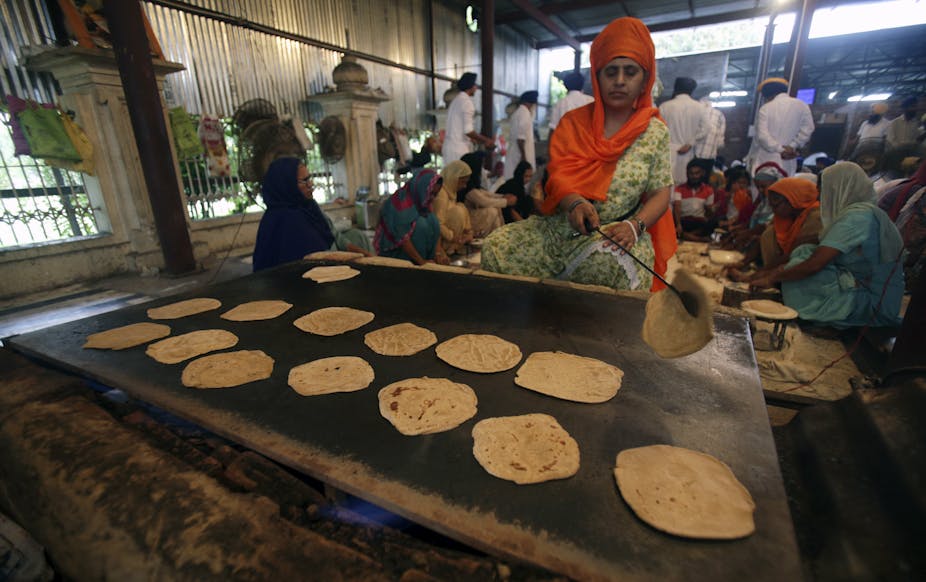This April, two Sikh organisations in New Delhi and Amritsar sent food relief to victims in post-earthquake Nepal. Apart from contributing 25,000 food packets a day each, they sent out teams of cooks and volunteers to set up community kitchens. These served hot meals to over 10,000 people a day.
Meanwhile, in the UK, the homeless are turning to Sikh community kitchens for hot meals as demand for food banks rises.
By taking the traditional concept of the “langar”, or shared meal, out of the temple and onto the street, these community kitchens have extended the idea of service. Meals are offered free, and everything from the buying of the food, to the preparation of the meals, is based on donations.
Spirit of service
The importance of selfless service or “seva” has been emphasised in the lives and teachings of the Sikh gurus. According to Guru Nanak, the founder of the Sikh religion, sharing one’s time and wealth with those in need is the best possible action. The idea of “langar” as a community kitchen was developed by Guru Nanak in his settlement at Kartarpur, now in Pakistan.
Devotees would farm the land before preparing food and sharing the meal. Langar – which refers to the community kitchen as well as the food served – was developed as a practical manifestation of the teachings where devotees were encouraged to work hard and share the fruits of their labour.
Sharing a langar – which includes cooking, serving, eating and cleaning up – emphasised the idea of equality beyond any categorisations of caste, gender, social status, ethnicity, or religion.

Global communities
The introduction of “langar” into the Oxford English Dictionary in 2008 highlighted that this key tenet of the Sikh tradition had entered mainstream vocabulary. Those who experience langar in gurdwaras for the first time are often amazed at the scale of what is essentially a volunteer effort.
Gurdwaras are playing an important role as food banks, with an estimated 5,000 meals served to non-Sikhs each week by Britain’s 250 gurdwaras. In addition, Sikhs in the diaspora are increasingly making efforts to take langar out of the gurdwara so that it fulfils its core objective of serving the whole community.
In Canada, the Seva Food Bank serves food to low-income families. In Los Angeles, the Khalsa Food Pantry and Khalsa Peace Corps provide meals to the destitute, while the Sikhcess project provides food and clothing to the homeless in a number of local communities across the US.
British Sikhs have established food relief organisations in cities across the UK. The Midland Langar Seva Society in Birmingham, the Kirpa Food Bank in Wolverhampton, Guru Nanak’s Free Kitchen based in Doncaster and Edinburgh, the Bedford Langar project, the Sikh Welfare and Awareness Team (SWAT) based in London and Nishkam Help based in Birmingham and Leeds are some examples.
In addition to contributing to the communities they live in, Sikh charities such as United Sikhs also contribute to humanitarian efforts in different parts of the world as needed. Khalsa Aid, a UK based Sikh charity, which has provided disaster relief in Albania, Turkey, Somalia and Pakistan, made the headlines in 2014 when British Sikhs helped the Thames Valley and Somerset flood victims by delivering sand bags, food and medical supplies to those affected.
Demonstrating values and beliefs
The vision behind much of this food relief lies in the spirit of selfless service. The offering of food to all as a central tenet of the Sikh tradition has meant that Sikhs are often the go-to community for food relief. Indeed, given their non-proselytising nature, Sikhs are able to use langar as a practical demonstration of the values promoted by the Sikh gurus rather than simply talking about their beliefs.
In my research on the religious lives of young British Sikhs, I found that many wished to put the teachings of the Gurus into practice. Setting up langar-based organisations across the world and re-emphasising langar as a kitchen by the community, for the community, is a return to the teachings where the “community kitchen” exists to serve all.
For these Sikhs in diaspora, rather than simply referring to members of a particular ethno-religious group, “community” refers to anyone they engage with at a local, national or even international level. This view extends the idea of langar to the whole world, and allows them to put into practice the ideal of “Sarbat Da Bhalla” or, “working for the betterment of all”.

